I have the same issue (USB port works with MacBook pro but not with ios devices). Moog indicated they could fix if I sent it in, but since I'm able to use my ios devices with a widi master (Bluetooth connected to midi ports) I've not taken them up on it.
Actual information on Claravox
I have the same issue (USB port works with MacBook pro but not with ios devices). Moog indicated they could fix if I sent it in, but since I'm able to use my ios devices with a widi master (Bluetooth connected to midi ports) I've not taken them up on it.
How strange! I’ve been extremely busy doing bassoon stuff these past several weeks and haven’t had much opportunity to play theremin lately but my CVox is acting up. As I finally received the stand, just last week - three full months after I received the instrument, and now my CVox has started to act up. As I don’t move it, I’m beginning to think I may have to send it in.
I experienced the dreaded mute switch doesn’t work problem two nights again and had to switch the power off and then back on again. I’ve also just started having problems with both the pitch and volume antennas. At first, I thought it may have something to do with the fact that the stand is simply too tall and I have to stand to play it (I prefer to sit). Due to the change in my position, I thought it might have something to do with body capacitance. However, I now strongly suspect there may be something wrong with the instrument itself.
The situation with the pitch antenna is that pitch does NOT seem to hold steady. I try to stand as still as possible and then place my hand in position without moving - even so, the pitch changes while I’m frozen in position - that’s driving me nuts. I even wondered if my breathing might be causing the pitch changes but that doesn’t seem to be it. Strange!
Suddenly, the volume antenna seems to act more as a on/off switch rather than to adjust dynamics. Again, very strange. I’m going to give it another day and if these problems don’t settle down, I’ll send it to Moog.
I wonder if others are experiencing the same things.
My IPad will be an iPad Pro 11. I will be trying the usbc into usb. Is this different than lightning into usb?
Thanks. I really hope it works.
Do you like the program, those of you that have it working?
My Claravox is 333 I have had little problems with mine so far.(Knock on wood). I love playing it and the sound it produces.
My IPad will be an iPad Pro 11. I will be trying the usbc into usb. Is this different than lightning into usb?Thanks. I really hope it works.Do you like the program, those of you that have it working?My Claravox is 333 I have had little problems with mine so far.(Knock on wood). I love playing it and the sound it produces.
Yes, this is the same thing. Other people have been able to use this with iOS devices, so it could very well be that yours works fine. You'll need an adapter like one of these: https://www.apple.com/shop/product/MK0W2AM/A/lightning-to-usb-3-camera-adapter
The claravox app is a bit intimidating TBH. I've used it to browse different timbres (most of which are not very musical, more like sound effects), but I've been able to use it to control some things with my expression pedal.
I experienced the dreaded mute switch doesn’t work problem two nights again and had to switch the power off and then back on again. I’ve also just started having problems with both the pitch and volume antennas. At first, I thought it may have something to do with the fact that the stand is simply too tall and I have to stand to play it (I prefer to sit). Due to the change in my position, I thought it might have something to do with body capacitance. However, I now strongly suspect there may be something wrong with the instrument itself.The situation with the pitch antenna is that pitch does NOT seem to hold steady. I try to stand as still as possible and then place my hand in position without moving - even so, the pitch changes while I’m frozen in position - that’s driving me nuts. I even wondered if my breathing might be causing the pitch changes but that doesn’t seem to be it. Strange!
Suddenly, the volume antenna seems to act more as a on/off switch rather than to adjust dynamics. Again, very strange. I’m going to give it another day and if these problems don’t settle down, I’ll send it to Moog.
I wonder if others are experiencing the same things.
I've not had these problems, but they do sound like what some other people have reported. Field instability is often associated with poor grounding (breathing will affect the pitch field on any theremin, but only a bit). If these changes started when you put it on the wooden stand, that sounds suspicious - if you had a metal stand before it could change the capacitance, particularly if you are in a carpeted room...maybe try switching back to the old stand and see if it makes a difference?
I have an adapter that plugs into Claravox usb and has usbc on other end. I hope this works. I really want a good violin and cello sound. Thanks for all your help. Bendra You are always a positive and helpful person with your posts. They are appreciated.
Thanks again...
The software worked perfectly and connected flawlessly. Very complex but fun. Really makes sounds easier to manipulate and opens lots of musical doors. I agree most sounds weren’t as musical as I like but others were easy to alter to enjoyable tones. I will enjoy exploring its many levels....
Claravox Repair - Take 3
Jeff (ContraDude) came back by yet again today with his ailing serial #00218 Claravox. It's always great visiting with Jeff, perhaps someday we can do so under less dire conditions! :-)
Symptoms were:
1. On/off volume field behavior (lack of shading) and
2. unsteady pitch field.
Of course, once we hooked it all up at my house it worked fine (I seem to have this effect on other people's recalcitrant electronics, they're always on their best behavior around me - my own electronics however...). Having seen this awesome site roll-calling the Cvox issues, with proposed fixes, as well as pics of Moog's recent rework, it was time to get a bit more scientific / aggressive.
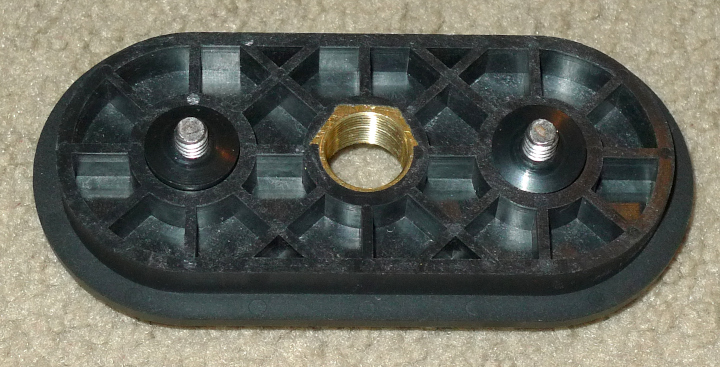
First off, I took a DMM to the stand mount. There was zero electrical connectivity between the central brass thread and the two outer threads, so a metal stand probably can't influence the operation very much.
Next, I inserted a selectively conductive rod (a weird test antenna from my D-Lev development days) connected to a DMM into the volume loop socket to examine electrical connectivity there. The top section made connection only after being plugged almost all the way in, pulling it out 5mm from full insertion disconnected it. The bottom section however made a connection when the rod was inserted a mere 17mm, and this continued until the rod was fully inserted, approximately 53mm, the difference being 36mm.
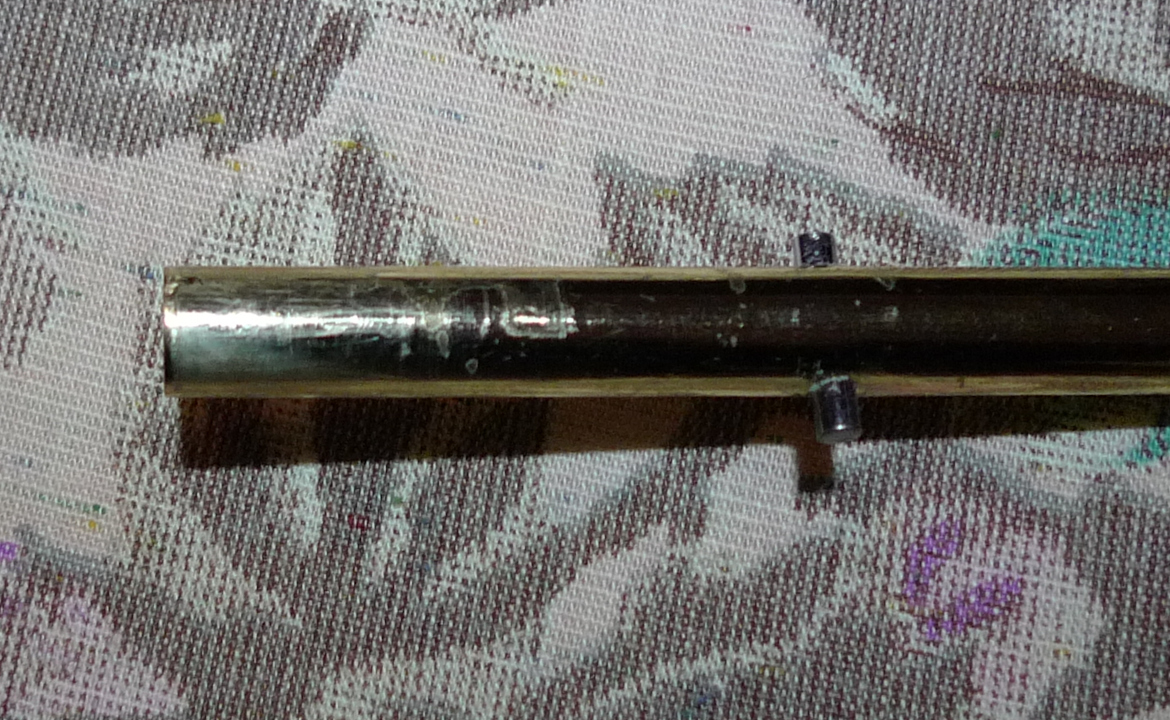
Indeed you can clearly see above the scratching of this bottom contact on the bottom of the volume rod end.
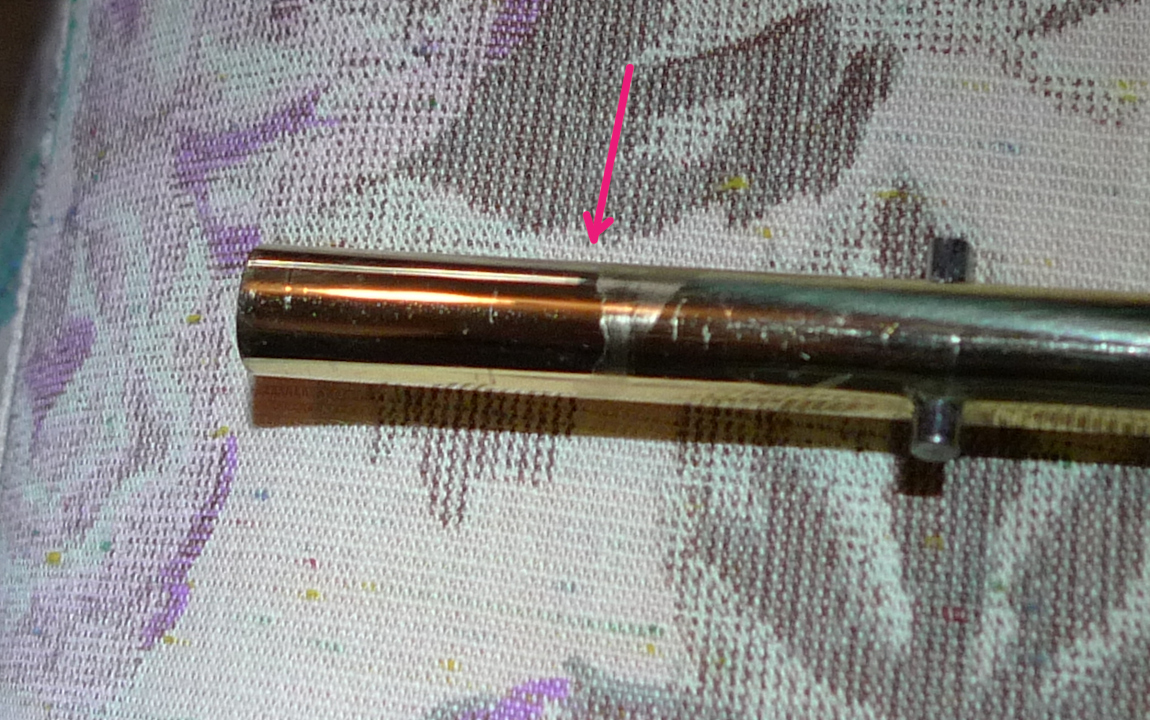
So it seemed to be a good idea to remove 40mm or so of the varnish from the end of the antenna rod. We used acetone to do this, and it did a good job. It was applied with a Q-Tip and wiped off with a paper towel. We tested it with the DMM set to low ohms range to make sure it was very conductive. I think this is maybe a better solution than simply sanding the varnish off, as that tends to remove the brass plating (or whatever) too.
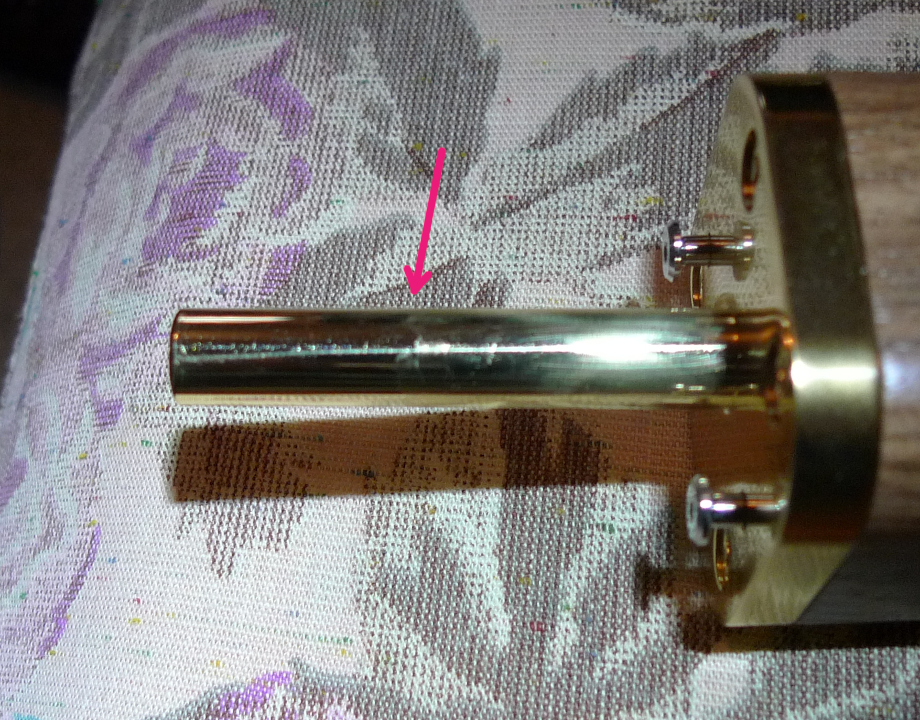
In the same way, we removed ~40mm of varnish from the pitch antenna post (see above). For thoroughness, we also applied some acetone to the antenna rod threads, as well as the mating threads in the arm, and exercised the threaded connection some, just in case there was any varnish there.
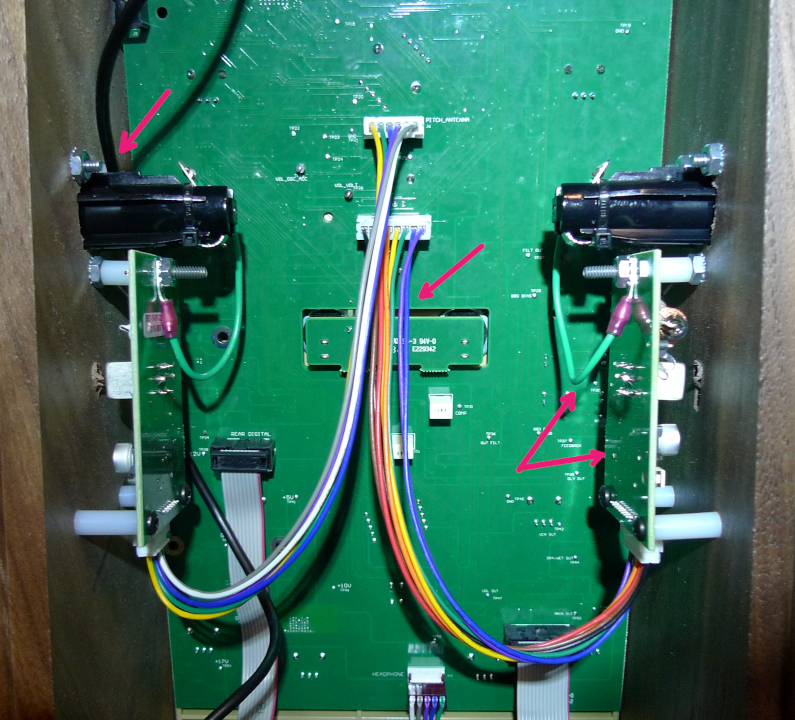
While we had the back off, we noticed (upper left) that the USB cable ran quite close to the pitch antenna arm socket. We also noticed (center) that the pitch and volume oscillator cable assemblies were quite close to each other and unrestrained. Finally, we noticed (lower right) that the volume rod socket connection wire (a high impedance) ran somewhat near the oscillator board ground plane. The Cvox could really use better cable management...
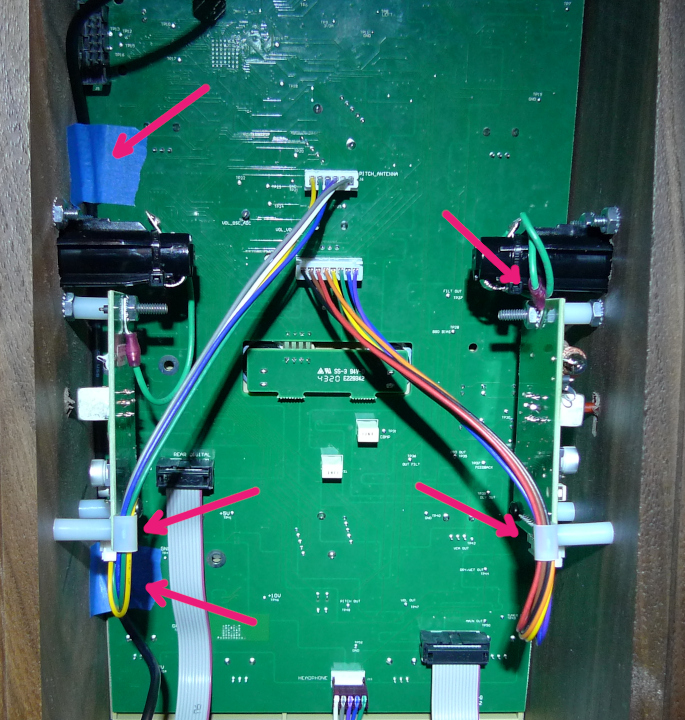
So we taped the USB cord back into the corner, added nylon wire clamps to the pitch and volume cable assemblies, and rearranged the volume connection wire to position it away from the oscillator board ground plane. In retrospect, I probably should have done this for the pitch wire too.
We had to re-tune the volume oscillator with the plastic tuning tool, but after that it seemed to be working well. I do wish Moog would release a technical bulletin or something explaining exactly how to do this, as the volume knob and volume calibration can confound exactly what the heck is going on. I noticed a region near zero volume with my fingers in the loop, where the volume didn't seem to drop as fast as one might expect, and I suspect this may be the volume leakage problem folks are complaining about in traditional mode.
Jeff showed me how to do the rather cryptic field calibration. Maybe I'm not sufficiently wise to the feedback, but it didn't seem clear at all as to when to release the final button press. I think field calibration is important enough, and likely performed often enough, that it could use a dedicated button or two on the front panel.
So, third time's the charm? ;-)
[EDIT] Due to the 36mm contact point, you should remove ~40mm of varnish from the antenna ends.
Claravox Repair - Take 3 Jeff (ContraDude) came back by yet again today with his ailing serial #00218 Claravox. Symptoms were: 1. On/off volume field behavior (lack of shading) and2. unsteady pitch field. Of course, once we hooked it all up at my house it worked fine (I seem to have this effect on other people's recalcitrant electronics, they're on their best behavior around me - my own electronics however...).
Of course, it worked fine at your place! It's just like taking a car into the shop - it always works when it's supposed to mis-behave! Anyway, I just arrived home and the CVox is definitely working better (albeit still slightly quirky). I need to play it some more before I'm able to provide a more informed review of it's current state. However, as Dr. D-Lev (dewster/Eric) is simply brilliant, I'm always grateful for his expert surgical skills. Perhaps I should move in so I'll always have someone to examine and tune-up my contumacious CVox - I think I'll start packing tonight! Hope both he and his lovely wife won't mind my cat . . . LOL!
dewster > So we taped the USB cord back into the corner, added nylon wire clamps to the pitch and volume cable assemblies, and rearranged the volume connection wire to position it away from the oscillator board ground plane. In retrospect, I probably should have done this for the pitch wire too. We had to re-tune the volume oscillator with the plastic tuning tool, but after that it seemed to be working well.
Hmmm . . . does this mean I need to bring it back for adjustments to the pitch wire? ![]()
Actually, I'm extremely fortunate to have Eric as the world's greatest theremin surgeon! He always knows what to do in order to pacify my increasingly less quirky CVox. Thanks, Eric!
"Anyway, I just arrived home and the CVox is definitely working better (albeit still slightly quirky)." - ContraDude
Ooo, is that "normal quirky" or "new & different quirky"?
"Hmmm . . . does this mean I need to bring it back for adjustments to the pitch wire?"
I only noticed this after editing the pix. That's a medium impedance point (the EQ coil is in the pitch arm) so it's probably OK. But it's sorta weird that Moog positioned it so close to the front PWB, where a lot is going on, when they didn't have to. It's like they hired a car mechanic to do these post production repairs.
"Perhaps I should move in so I'll always have someone to examine and tune-up my contumacious CVox"
Hey now, this is a family blog! ;-)
You must be logged in to post a reply. Please log in or register for a new account.

